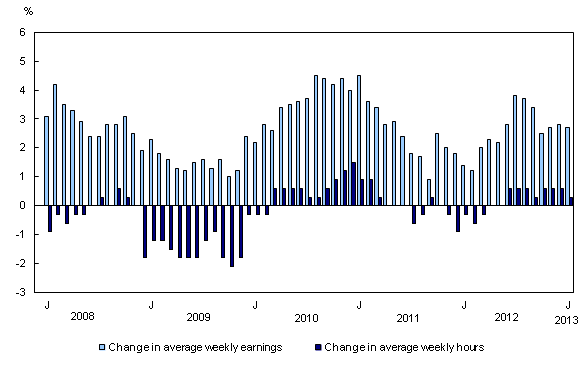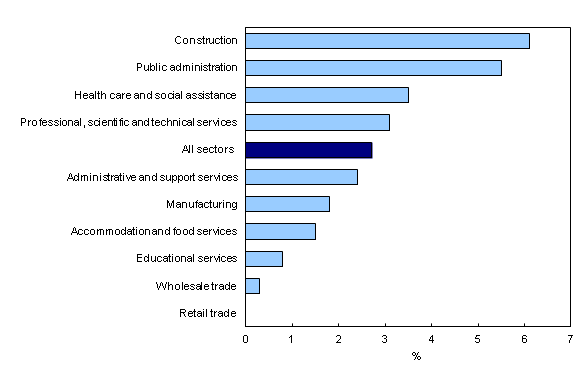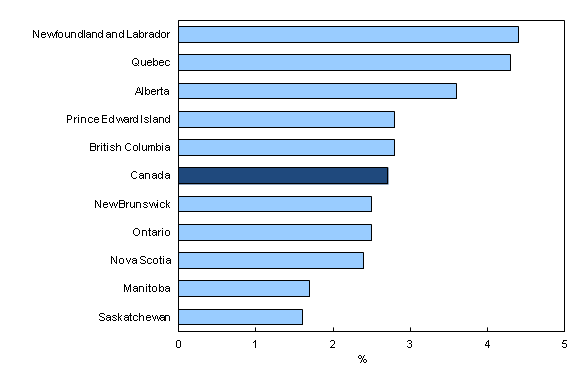Payroll employment, earnings and hours, January 2013
Archived Content
Information identified as archived is provided for reference, research or recordkeeping purposes. It is not subject to the Government of Canada Web Standards and has not been altered or updated since it was archived. Please "contact us" to request a format other than those available.
Released: 2013-03-27
Average weekly earnings of non-farm payroll employees were $908 in January, up 0.1% from the previous month. On a year-over-year basis, earnings increased 2.7%.
The 2.7% increase in earnings during the 12 months to January reflects a number of factors, including wage growth, changes in composition of employment by industry, occupation and level of job experience, as well as average hours worked per week. In January, non-farm payroll employees worked an average of 33.0 hours per week, unchanged from the previous month but up from 32.9 hours a year earlier.
Average weekly earnings by sector
Year-over-year growth in average weekly earnings outpaced the national average in four of the largest industrial sectors, led by construction and public administration.
Average weekly earnings in construction increased 6.1% to $1,172 in the 12 months to January. The largest growth was in the construction of buildings as well as heavy and civil engineering construction.
Weekly earnings in public administration increased 5.5% to $1,189. The most notable growth occurred in local, municipal and regional public administration.
In health care and social assistance, weekly earnings rose 3.5% to $831, led by growth in hospitals and ambulatory health care services.
Average weekly earnings in professional, scientific and technical services increased 3.1% in January to $1,256, with gains in computer systems design and related services as well as legal services.
Among the largest industrial sectors, wholesale and retail trade had the lowest year-over-year growth. Earnings in wholesale trade edged up 0.3% to $1,061, while in retail trade, they were unchanged from 12 months earlier at $524 in January.
Average weekly earnings by province
Year-over-year earnings growth of non-farm payroll employees was above the national average in five provinces, with the highest growth in Newfoundland and Labrador and Quebec.
Newfoundland and Labrador had the largest year-over-year growth in January, with average weekly earnings increasing by 4.4% to $947. The main contributors to this earnings growth were construction and health care and social assistance.
In Quebec, average weekly earnings rose 4.3% to $835 in the 12 months to January.
Alberta continued to have the highest average weekly earnings at $1,090, up 3.6% compared with 12 months earlier.
Non-farm payroll employment by sector
Total non-farm payroll employment increased by 16,300 in January, following a decline of 31,200 the previous month.
In January, the number of payroll employees rose most notably in health care and social assistance; retail trade; and construction. At the same time, there was a notable decrease in administrative and support services.
On a year-over-year basis, payroll employment rose by 238,500 or 1.6%.
Among all sectors, mining and quarrying, and oil and gas extraction posted the highest 12-month growth rate in payroll employment at 7.4%, followed by construction (+6.3%) and real estate and rental and leasing (+3.3%).
Note to readers
The Survey of Employment, Payrolls and Hours (SEPH) is a business census of non-farm payroll employees. Its key objective is to provide a monthly portrait of the level of earnings, the number of jobs and hours worked by detailed industry at the national, provincial and territorial level.
Estimates of average weekly earnings and hours are based on a sample and are therefore subject to sampling variability. Payroll employment estimates are based on a census of administrative data and are not subject to sampling variability.
Statistics Canada also produces employment estimates from its monthly Labour Force Survey (LFS). The LFS is a household survey, the main objective of which is to divide the working-age population into three mutually exclusive groups: the employed (including the self-employed), unemployed and not in the labour force. This survey is the official source for the unemployment rate and collects data on the socio-demographic characteristics of all those in the labour market.
As a result of conceptual and methodological differences, estimates of changes from SEPH and LFS do differ from time to time. However, the trends in the data are quite similar.
Unless otherwise stated, this release presents seasonally adjusted data, which facilitates comparisons by removing the effects of seasonal variations. For more information on seasonal adjustment, see Seasonal adjustment and identifying economic trends.
Non-farm payroll employment data are for all hourly and salaried employees, as well as the "other employees" category, which includes piece-rate and commission-only employees.
Average weekly hours data are for hourly and salaried employees only and exclude businesses that could not be classified to a North American Industry Classification System (NAICS) code.
All earnings data include overtime pay and exclude businesses that could not be classified to a NAICS code. Earnings data are based on gross taxable payroll before source deductions.
Average weekly earnings are derived by dividing total weekly earnings by the number of employees.
With each release, data for the current reference month are subject to revision. Data have been revised for the previous month. Users are encouraged to request and use the most up-to-date data for each month.
Revisions
With this release, SEPH has started using the 2012 North American Industry Classification System (NAICS) instead of NAICS 2007. Data was revised historically back to 1991. As well, seasonally adjusted data were revised based on the latest seasonal factors. Historical revisions were also made to a small number of industries by province or territory. These changes have little impact on SEPH estimates.
A data table is available from the Browse by key resource module of our website under Summary tables.
Data on payroll employment, earnings and hours for February will be released on April 25.
Contact information
For more information, contact us (toll-free 1-800-263-1136; infostats@statcan.gc.ca).
To enquire about the concepts, methods or data quality of this release, contact Thao Sohn (613-951-2297; thao.sohn@statcan.gc.ca), Labour Statistics Division.
- Date modified:




